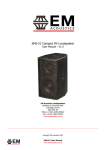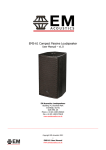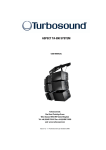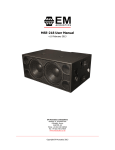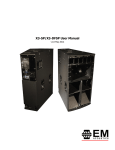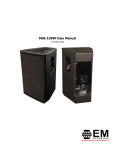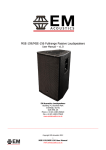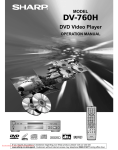Download EM Acoustics HALO System User manual
Transcript
HALO System User Manual V2.2 August 2010 Page 2 of 39 Contents Declaration of Conformity Page 3 1.0 - Introduction Page 4 2.0 - The HALO System Page 5 3.0 - Connections, Processor & Amplifier Selection Page 6 4.0 - Flying HALO Systems Page 9 4.1 - Assembling Flown Arrays with subwoofers Page 12 4.2 - Assembling Flown Arrays without subwoofers Page 22 4.3 - Assembling Flown Arrays with the FG-HALO grid Page 28 5.0 - Ground Stacked Systems Page 29 6.0 - Servicing Information Page 30 Appendix A – Technical Specifications Page 33 Appendix B – Technical Drawings Page 35 Appendix C – Spare Parts Page 37 Appendix D – Warranty Information Page 38 HALO system User Manual V2.2 August 2010 Page 3 of 39 DECLARATION OF CONFORMITY The products contained within this manual conform to the requirements of the EMC Directive 89/336/EEC, amended by 92/31/EEC and to the requirements of the Low Voltage Directive 73/23/EEC amended by 93/68/EEC. EMC Emission EN55103-1:1996 Immunity EN55103-2:1996 Electrical Safety EN60065:1993 RECYCLING This product and its packaging constitute the applicable product according to the WEEE directive. Please ensure that at the end of the working life of this product, it is disposed of sensibly in accordance with local and national recycling regulations. The packaging supplied with this product is recyclable. Please retain all packaging, however if disposing of this packaging please ensure that you comply with local recycling regulations. These products also all comply to the RoHS Directive 2002/95/EC. HALO system User Manual V2.2 August 2010 Page 4 of 39 1.0 - Introduction Thank you for purchasing the revolutionary HALO compact line array system from EM Acoustics. The entire HALO system family has been designed and rigorously tested to give you the utmost in sonic performance and many years of reliable, trouble-free operation. Please take the time to read this user manual thoroughly to ensure you get the best performance from your system and to ensure you set it up correctly and safely. If you have any questions or are in any doubt whatsoever about any aspect of your HALO system, please do not hesitate to contact us directly or your local EM Acoustics representative. The HALO system is one of the only line array loudspeaker systems in the world to utilize genuine ribbon transducers for high frequency reproduction, resulting in incredible detail and clarity as well as superior feedback rejection. The ribbon driver, coupled with the patent-pending diffraction manifold means HALO offers a vastly superior consistent 90degree horizontal coverage pattern. Added to this is the incredibly intuitive flying system, renowned EM Acoustics passive crossover technology and the one-to-one customer support that EM Acoustics is known for and you should be congratulated for purchasing one of the finest loudspeaker products on the market today. This manual contains all the information you should need on topics of set up, amplifier connection, flying & stacking and basic service. If you feel we have missed anything, or you have a question not covered by this manual, please visit our website www.emacoustics.co.uk and send us a message or give us a call – we‟re only too happy to help. Unpacking Please take care when unpacking your loudspeaker system. Once unpacked, please inspect each enclosure thoroughly for any transit damage and in the case of any damage please notify your carrier immediately. It is the responsibility of you, the consignee , to instigate any claim. Please retain all original packaging in case of future re-shipment. HALO system User Manual V2.2 August 2010 Page 5 of 39 2.0 - The HALO System The HALO system comprises two loudspeaker models and associated flying hardware. Details of the different components are given below – all enclosures and flying grids work on the same principles and use similar if not identical hardware. a) HALO 3-way biamplified line array loudspeaker The HALO enclosure is a three-way, bi-amplified design incorporating some of the most advanced loudspeaker technologies available today. The centerpiece of the HALO enclosure is the bespoke Air Motion Transducer, coupled to our patentpending variable diffraction manifold. This combination gives seamless 90-degree coverage from 2KHz right up to 18KHz. Integral flying hardware allows for quick & easy array assembly, with each enclosure pivoting on the diaphragm of the ribbon transducer thereby keeping the distance between adjacent HF units constant. Two flat-diaphragm 6.5” drive units handle midrange frequencies, linked via an internal passive crossover to two LF 6.5” drive units to extend the enclosure response down to 75Hz. b) HALO-S compact flyable subwoofer The HALO-S subwoofer is based upon the hugely successful EMS-215 dual 15” quasi-bandpass subwoofer. Incorporating flying hardware following the same concept as the HALO enclosure, plus a detachable base board for ground-stacking and storage. c) MFG-HALO master flying grid The MFG-HALO grid is the main grid for the HALO system which can be used for flying HALO enclosures on their own, but must be used to suspend HALO-S subwoofers. d) FG-HALO compact flying grid The more compact FG-HALO grid can be used for flying HALO enclosures alone, and is often the better choice where smaller numbers of HALO enclosures are required and/or less down-angle for the array is required. e) SLG-HALO sub-link flying grid The SLG-HALO link grid must be used when assembling arrays including both HALO and HALO-S enclosures. The SLG-HALO provides the mechanical interface between the HALO-S subwoofer and the much shallower HALO enclosure. HALO system User Manual V2.2 August 2010 Page 6 of 39 3.0 - Connections, Processor and Amplifier Selection Connecting your loudspeakers HALO enclosures are bi-amplified and use Neutrik Speakon TM NL4 connectors - as such they require 4-core cable to function correctly. Standard pin connections are LF/MF on pins 1+/1- and HF on pins 2+/2-. HALO-S subwoofers are wired pins 1+/1- with pins 2+/2- connected as a link-through. Cable Selection All cables add to the system impedance, and as such careful selection is required depending on your amplifier setup and overall system impedance. Recommended maximum cable lengths are given below: Conductor Area 1.0mm2 1.5mm2 2.0mm2 2.5mm2 4.0mm2 6.0mm2 Maximum Recommended Cable Length 4 ohms 8 ohms 16 ohms 11m 17m 22m 29m 44m 66m 44m 68m 88m 116m 176m 264m 22m 34m 44m 58m 88m 132m IMPORTANT NOTE REGARDING SYSTEM IMPEDANCE The HALO HF drive unit drops to 4 ohms across a reasonable portion of its operating band. This can cause problems with some amplifiers when connecting the high frequency sections of more than two HALO enclosures in parallel on an amplifier channel. However, with the cable lengths involved in most line array usage scenarios, there is sufficient impedance in the cable alone to bring the impedance up to a suitable level to prevent amplifier problems. We would recommend when connecting 3 or more HALO high frequency sections to a given amplifier channel, ensure cable runs of at least twenty metres between the amplifier and the loudspeaker. Amplifier Powers We recommend the following power inputs for HALO enclosures: HALO LF/MF (8 ohm impedance) HALO HF HALO-S (4 ohm impedance) 500W RMS, 1000W Program 375W RMS, 750W Program 1000W RMS, 2000W Program HALO system User Manual V2.2 August 2010 Page 7 of 39 These amplifier powers can be scaled up – for example for running four HALO enclosures in parallel from the same amplifier (ch 1 LF/MF, ch 2 HF) we would recommend an amplifier capable of delivering 2500-3000 watts into a 2-ohm load. NOTE: A small amplifier working too hard is much more likely to damage your loudspeakers than a large amplifier working well within its limits! HALO system User Manual V2.2 August 2010 Page 8 of 39 Processor Selection & DSP Settings The HALO system requires a suitable DSP loudspeaker management system to allow for crossover points, system EQ and delay. EM Acoustics recommends either XTA 4-series processors or Lake processing – either stand-alone units or incorporated into the LabGruppen PLM series of amplifier products. The DSP program detailed below is based around a 12-HALO system flown with a single HALO-S subwoofer at the top of the array. Crossover points between HALO/HALO-S are of course at the user‟s discretion, as are gain structures. We would strongly suggest that the HALO settings (shown in bold below) are not altered from our recommended settings as this can result in poor performance and/or damage to the HALO components. The other two EQ points will vary depending on the size of the array used – for smaller arrays, less HF boost and 202Hz cut will be required and vice-versa. LMF/HMF Gain: Polarity: Delay: HPF: LPF: EQ 1: EQ 2: EQ 3: 0dB (+) 0ms 80.3Hz, 24dB/Oct 1k78Hz, 48dB/Octave 1k82Hz 516Hz 202Hz Linkwitz-Riley Linkwitz-Riley Q=9 Q=5 Q=1.5 -14dB -9dB -5dB HF Gain: Polarity: Delay: HPF: LPF: EQ 1: EQ 2: EQ 3: EQ 4: +11dB (-) 0.5417ms 7k55Hz, 12dB/Oct 20 kHz, 48dB/Octave 1k78Hz 4k40Hz 9k33Hz 12kHz Linkwitz-Riley Linkwitz-Riley Q=4 Q=2 Q=4 High Shelf Q=1 -4dB -2dB -4dB +8dB HALO-S Gain: Polarity: Delay: HPF: LPF: +2dB (+) 0.0ms 35Hz, 24dB/Oct Butterworth 95Hz, 24dB/Octave Linkwitz-Riley HALO system User Manual V2.2 August 2010 Page 9 of 39 4.0 - Flying HALO systems System Overview The flying system for the HALO system has been specifically designed to be flexible, intuitive and reliable. Please read this section of the user manual extremely carefully as the rigging of loudspeakers is a very serious matter with potentially fatal consequences should anything go wrong. If you are in ANY DOUBT WHATSOEVER, contact a reputable rigging company or your local EM Acoustics representative. IMPORTANT SAFETY CONSIDERATIONS The HALO rigging system has been designed and constructed to a very high standard of safety, and tested to demanding specifications. To ensure the highest standards of safety, the following information on array assembly must be exactly followed and understood. Only use EM Acoustics recommended rigging hardware and accessories, which are specifically designed for the purpose. Do not use HALO flying hardware for any other loudspeaker system – the components are specifically designed to work with the HALO system and are not interchangeable with any other EM Acoustics loudspeaker product or any other loudspeaker system. The use of HALO flying hardware with other manufacturers‟ systems may compromise the safety standards and EM Acoustics, and its parent company, are in no way liable for any loss, damage or injury caused by such practice. Do not modify or alter the HALO hardware or accessories, nor use them in any way other than that described in this manual. Rigging components supplied as part of the HALO system are in no way interchangeable and should not be used as such. The component parts of the HALO rigging assembly should only be assembled in the manner described in this manual, using the fasteners and fixings stated herein. The use of fasteners and methods of assembly not described in this manual may result in an unsafe assembly and as such EM Acoustics will not be responsible for any loss, damage or injury caused by such practice. Welding, drilling or any other means of modifying any part of the flying hardware or permanently fixing components to each other is strictly forbidden. Rigging assemblies must only be assembled using the appropriate parts and fixings as described in this manual, explicitly following the assembly instructions given herein. Rigging components must only be fixed to EM Acoustics HALO loudspeaker systems, using the correct cabinet location points, assembly methods and fasteners specifically described within this manual. HALO system User Manual V2.2 August 2010 Page 10 of 39 Walls, floors and ceilings must be capable of supporting the actual load placed upon them. The rigging hardware must be safely and securely fixed to both the loudspeaker system and the supporting structure. When mounting components on walls, floors or ceilings ensure that all fixings and fasteners used are of an appropriate size and load rating. Wall and ceiling claddings, and the construction/composition of walls and ceilings also need to be taken into consideration when determining if a given suspension method is safe. Secondary Safeties It is best practice to ensure that all loudspeakers flown in any given environment should be provided with a second, independent and properly rated safety suspension point in addition to the principle load bearing means of suspension. Steel wire ropes or steel chains of an approved construction and load rating only may be used as secondary safeties. Plastic covered steel chains may not be used as secondary safeties under any circumstances. Also ensure that all local and national laws are complied with when determining your primary and secondary suspension points. Safety Inspections Carefully inspect all flying system components prior to use for defects or signs of damage prior to assembling a HALO array. If any components damaged or you suspect them to be damaged, DO NOT USE THEM. Regular scheduled tests – which are much more rigorous than visual inspections – of all rigging components must also be carried out. Safety legislation, and test/inspection requirements, will vary from country to country and as such it is the user‟s responsibility to ensure that local regulations are adhered to. In most cases, annual independent tests & inspections carried out by a suitably approved and qualified inspector will be required. EM Acoustics recommends detailed logbooks be kept of all inspections and load tests to ensure an accurate record is kept of the testing for each EM Acoustics rigging accessory. When flying any loudspeaker system, always wear protective headwear, footwear and eye protection in accordance with local regulations. The rigging of a flown loudspeaker system may be dangerous if not undertaken by a suitably experienced and qualified rigger. Installation & fixing of all hanging points should only be carried out by a professional rigger in accordance with local legislation as well as the rules of the venue. The house rigger and/or venue manager must always be consulted. HALO system User Manual V2.2 August 2010 Page 11 of 39 Safety Factors The HALO system is designed to work within the following safety factors: MFG-HALO – Safety factor of 4 22 x HALO enclosure OR 20 x HALO enclosure 1 x SLG-HALO grid 1 x HALO-S enclosure OR 16 x HALO enclosure 1 x SLG-HALO grid 2 x HALO-S enclosures MFG-HALO – Safety factor of 6 16 x HALO enclosure OR 12 x HALO enclosure 1 x SLG-HALO grid 1 x HALO-S enclosure SLG-HALO – safety factor of 4 20 x HALO enclosure SLG-HALO – safety factor of 6 14 x HALO enclosure SLG-HALO – safety factor of 8 10 x HALO enclosure HALO system User Manual V2.2 August 2010 Page 12 of 39 4.1 - Assembling Flown Arrays with Subwoofers HALO system User Manual V2.2 August 2010 Page 13 of 39 This section describes setting up of a HALO array similar to that shown above, comprising HALO-S subwoofers and HALO elements. Step One – MFG-HALO grid preparation The drop links for the MFG-HALO grid are stored inside the chassis of the flying grid for transport. The first step is to prepare these links ready to fly the system. The MFG-HALO grid has five link positions: Front Drop Links – these are removable and are used for flying both HALO-S and HALO enclosures. Two different sets of front links are provided – larger links for HALO-S subwoofers and smaller links for HALO enclosures. The alternate links are stored in recesses on the sides of the MFG grid as shown below. Rear Drop Links – these are fixed and are only used for flying HALO-S Subwoofers. Central Splay Link – this is fixed and is only used for flying HALO enclosures. Firstly, ensure you have the correct front drop links in place to fly your chosen system. In this example, we are flying a HALO-S subwoofer at the top of the array and as such we want the larger of the two links as shown in the image below. HALO system User Manual V2.2 August 2010 Page 14 of 39 Should you need to change the links, the alternative links are stored on the sides of the MFG grid and are held in place by ball-lock pins. Release the pins as shown below and remove the alternate links. When fitting the new links, the link pivots on the upper ball-lock pin and is locked in place for use by the lower pin. Ensure when fitting the new link into the grid that the thicker steel boss faces to the inside of the MFG-HALO grid. It is easier to fit the new links from the bottom of the grid. Once you have established the appropriate front drop-links, move the links into the usage position by removing the lower ball-lock pin which will allow the link to swing freely, and then replace the ball-lock pin to lock the link in position. HALO system User Manual V2.2 August 2010 Page 15 of 39 This process should now be repeated for the rear links – however the rear links are pivoted permanently on a bolt. As such, simply release the ball-lock pin to allow the link to sit into the usage position, replace the ball-lock pin and the link is now ready for use. IMPORTANT NOTE: For both front & rear links, the locking ball-lock pin MUST be in position prior to attempting to fly the system. Step Two – Selecting & fitting pick-up links The MFG-HALO grid provides two means of attaching the grid to your chosen primary mounting point. The first, and most common is by using the movable pick-up links which allow for both single point and dual point pick-up. These links are stored for transit on the side of the MFG grid and are secured in place by two 3/8” ball-lock pins. HALO system User Manual V2.2 August 2010 Page 16 of 39 Fit the links into the groove down the central spine on the MFG grid, and slide the link along to the desired position. The different pairs of holes for the 3/8” pins along the length of the spine allow for a variety of different positions for the pick-up link, with complete flexibility. Repeat this process for the second pick-up link. IMPORTANT NOTE: Both 3/8” ball-lock pins MUST be secured on each pick-up link being used. 3.25 ton bow shackles can then be used to select the appropriate connection hole in each pick-up link as shown above. The second means of securing pick-up points on the MFG-HALO grid is to use the four holes located front & rear on the grid to attach 3.25 ton bow shackles, and bridle between HALO system User Manual V2.2 August 2010 Page 17 of 39 them. An example of this procedure is shown in the photo below. These additional points can also be used to attach secondary safeties to the system. Ensure with whichever method you use for pick-up, that you have the MFG-HALO grid facing the right direction – indicated by the “FRONT” arrows on each side of the grid. Step 3 – Attaching HALO-S subwoofer enclosures Once you have your MFG-HALO flying grid prepared, and suspended from your primary load-bearing point, you are ready to assemble your HALO array. In this example we are using HALO-S subwoofers, therefore this is the first part of the array to be assembled. Position your HALO-S enclosure below the grid as shown in the photo above. Release the four ¼” ball-lock pins on the rigging system, and lower the grid into position – taking care to ensure that all four drop-links on the MFG-HALO grid locate within the rigging hardware on the cabinet. Once the grid is in position, secure the grid to the enclosure using the four ball-lock pins on the HALO-S enclosure. HALO system User Manual V2.2 August 2010 Page 18 of 39 Raise the MFG-HALO grid up, lifting the HALO-S subwoofer with it. Once clear of the ground, undo the four countersunk socket-head bolts which secure the base board to the HALO-S. Remove the board and retain for array disassembly. If adding a second subwoofer, repeat the procedure above. If you are only using one subwoofer, proceed to step 4 below. Step 4 – Attaching the SLG-HALO sub-link grid The SLG-HALO grid provides the mechanical link between the HALO-S and the much shallower HALO enclosure. It is specifically designed to give the same flexibility to the HALO array is if you were flying straight from a MFG-HALO grid. HALO system User Manual V2.2 August 2010 Page 19 of 39 Firstly, ensure you have the SLG-HALO grid in the correct orientation by observing the “FRONT” labels on the sides of the grid. Release the four ¼” ball-lock pins on the corners of the grid, to allow the bottom of the HALO-S rigging hardware to mate with the grid. Offer the grid up to the bottom of the HALO-S (this is possible with one person but is much easier with two!) and once in position, secure the grid to the bottom of the HALO-S using the four ball-lock pins secured to the grid itself. The last step prior to attaching your HALO enclosures is to set the desired splay angle for the first HALO enclosure in the array. For this, you need the central splay link on the SLGHALO grid. This link pivots on a bolt and is secured in the transit position by a ball-lock pin. Release this pin and rotate the link to the desired position – either 0 degrees (top HALO enclosure is parallel to the grid) or 5 degrees (top enclosure is angled down 5 degrees relative to the SLG grid). Secure in position with the ball-lock pin as shown below. HALO system User Manual V2.2 August 2010 Page 20 of 39 Step 5 – Attaching HALO enclosures This procedure is made much quicker by the use of flightcases or the WB-HALO wheelboard (shown below) as groups of HALO enclosures can be pre-assembled, resulting in much faster array assembly. As shown below, position your HALO enclosures beneath the array. Release the ball-lock pins on both sides of the front rigging, and also the lock position on the rear splay rigging. HALO system User Manual V2.2 August 2010 Page 21 of 39 Repeat the above procedure to attach additional HALO enclosures. With the attachment of each set, ensure the splay links between enclosures are locked in position and set at the “zero” mark. Once you have all of your HALO enclosures securely attached, lift the array clear of the ground to allow you to change inter-enclosure splay angles. Step 6 – Setting Splay Angles The HALO rigging system is designed to be extremely easy and intuitive to use, whilst retaining the highest standards of safety. Inter-enclosure splay can easily be adjusted using the single rear splay link on each loudspeaker. The splay link is clearly marked with numbers on the link itself and “A”, “B”, “C” on the locking pin holes. Two forms of position indicator are given – on the HALO enclosure label a description is given as to which angles each hole relates. Additionally, when sliding the link out of its housing, the first full number shown is the angle at which the link is set at – see photos below. HALO system User Manual V2.2 August 2010 Page 22 of 39 4.2 - Assembling Flown Arrays without Subwoofers The procedure to assemble the HALO system without subwoofers is largely identical to that described above. Step One – MFG-HALO grid preparation The drop links for the MFG-HALO grid are stored inside the chassis of the flying grid for transport. The first step is to prepare these links ready to fly the system. The MFG-HALO grid has five link positions: Front Drop Links – these removable and are used for flying both HALO-S and HALO enclosures. Two different sets of front links are provided – larger links for HALO-S subwoofers and smaller links for HALO enclosures. The alternate links are stored in recesses on the sides of the MFG grid as shown below. Rear Drop Links – these are not used. Central Splay Link – this is fixed and is only used for flying HALO enclosures. Firstly, ensure you have the correct front drop links in place to fly your chosen system. In this example, we are not flying HALO-S subwoofers and as such we want the smaller of the two links as shown in the image below. HALO system User Manual V2.2 August 2010 Page 23 of 39 Should you need to change the links, the alternative links are stored on the sides of the MFG grid and are held in place by ball-lock pins. Release the pins as shown below and remove the alternate links. When fitting the new links, the link pivots on the upper ball-lock pin and is locked in place for use by the lower pin. Ensure when fitting the new link into the grid that the thicker steel boss faces to the inside of the MFG-HALO grid. It is easier to fit the new links from the bottom of the grid. Once you have established the appropriate front drop-links, move the links into the usage position by removing the lower ball-lock pin which will allow the link to swing freely, and then replace the ball-lock pin to lock the link in position. HALO system User Manual V2.2 August 2010 Page 24 of 39 IMPORTANT NOTE: For both front & rear links, the locking ball-lock pin MUST be in position prior to attempting to fly the system. Step Two – Selecting & fitting pick-up links The MFG-HALO grid provides two means of attaching the grid to your chosen primary mounting point. The first, and most common is by using the movable pick-up links which allow for both single point and dual point pick-up. These links are stored for transit on the side of the MFG grid and are secured in place by two 3/8” ball-lock pins. Fit the links into the groove down the central spine on the MFG grid, and slide the link along to the desired position. The different pairs of holes for the 3/8” pins along the length of the spine allow for a variety of different positions for the pick-up link, with complete flexibility. Repeat this process for the second pick-up link. IMPORTANT NOTE: Both 3/8” ball-lock pins MUST be secured on each pick-up link being used. HALO system User Manual V2.2 August 2010 Page 25 of 39 3.25 ton bow shackles can then be used to select the appropriate connection hole in each pick-up link as shown above. The second means of securing pick-up points on the MFG-HALO grid is to use the four holes located front & rear on the grid to attach 3.25 ton bow shackles, and bridle between them. An example of this procedure is shown in the photo below. These additional points can also be used to attach secondary safeties to the system. Ensure with whichever method you use for pick-up, that you have the MFG-HALO grid facing the right direction – indicated by the “FRONT” arrows on each side of the grid. The last step prior to attaching your HALO enclosures is to set the desired splay angle for the first HALO enclosure in the array. For this, you need the central splay link on the MFG-HALO grid. This link pivots on a bolt and is secured in the transit position by a balllock pin. Release this pin and rotate the link to the desired position – either 0 degrees (top HALO enclosure is parallel to the grid) or 5 degrees (top enclosure is angled down 5 degrees relative to the SLG grid). Secure in position with the ball-lock pin as shown below. HALO system User Manual V2.2 August 2010 Page 26 of 39 Step 5 – Attaching HALO enclosures This procedure is made much quicker by the use of flightcases or the WB-HALO wheelboard (shown below) as groups of HALO enclosures can be pre-assembled, resulting in much faster array assembly. As shown below, position your HALO enclosures beneath the array. Release the ball-lock pins on both sides of the front rigging, and also the lock position on the rear splay rigging. HALO system User Manual V2.2 August 2010 Page 27 of 39 Repeat the above procedure to attach additional HALO enclosures. With the attachment of each set, ensure the splay links between enclosures are locked in position and set at the “zero” mark. Once you have all of your HALO enclosures securely attached, lift the array clear of the ground to allow you to change inter-enclosure splay angles. Step 6 – Setting Splay Angles The HALO rigging system is designed to be extremely easy and intuitive to use, whilst retaining the highest standards of safety. Inter-enclosure splay can easily be adjusted using the single rear splay link on each loudspeaker. The splay link is clearly marked with numbers on the link itself and “A”, “B”, “C” on the locking pin holes. Two forms of position indicator are given – on the HALO enclosure label a description is given as to which angles each hole relates. Additionally, when sliding the link out of its housing, the first full number shown is the angle at which the link is set at – see photos below. HALO system User Manual V2.2 August 2010 Page 28 of 39 Splay Angles – Above 10 degree It should be noted that the angles 10-15 degrees have been made accessible in order to allow „breaking‟ of the system. This is used in situations such as balcony coverage in theatres. In order to avoid reflections from balcony fronts (especially in relatively short throw applications) it can be helpful to employ large array angles to keep some of the energy off the balcony front before resuming coverage. Essentially above around 10 degrees splay – a „gap‟ in coverage will start to become far more noticeable – the higher angles have been included for just this reason – allowing greater flexibility should one need to „break‟ the array. It is appreciated that whilst it is not acoustically ideal to break the array in some ways (slight loss of coupling for example) we at EM acoustics believe the benefits of being able to approach otherwise challenging venues makes the addition of this feature worthwhile. 4.3 - Flying HALO systems using FG-HALO Grids If using the smaller FG-HALO grid, the procedure is exactly the same as above – barring grid preparation. There are no interchangeable links, as the FG-HALO grid cannot support HALO-S subwoofers. Simply secure the front links into the usage position, rotate the central splay link to the desired first-enclosure angle and secure 3.25 ton bow shackles in the appropriate pick-up holes and your grid is ready for use. HALO system User Manual V2.2 August 2010 Page 29 of 39 5.0 - Ground Stacking a HALO System The HALO system can be easily ground-stacked where necessary. The methods described below describe ground-stacking the system both with & without subwoofers. Method A – With HALO-S subwoofers The best way to imagine a ground-stacked HALO system is simply a flown system upside down. So, the first step is to move the base board from the HALO-S enclosure due to go on the bottom of the stack. In normal use, this board would be on the bottom of the enclosure (so that when sat on its feet, the EM logo is on the left of the enclosure as you look at it. Remove the four countersunk bolts in the board and move this board to the top of the enclosure. You can then position the HALO-S enclosure in the desired location, ready to assemble the system. Additional HALO-S subwoofers can be added to the stack if required, by removing the base board completely, turning the enclosure upside down and stacking in place as before. The SLG-HALO grid must now be prepared as in the section above, turned upside-down and secured to the HALO-S as before. You are now ready to assemble the HALO array itself. As the HALO enclosures have to be turned upside down, unless you have already prepared these upside down in their flightcases or wheelboards, we would recommend attaching the enclosures one at a time. Simply repeat the procedures detailed above for a flown system, attaching each enclosure one at a time. Method B – Without HALO-S subwoofers For ground-stacking HALO systems without the HALO-S, only use the MFG-HALO grid as the FG-HALO grid will not provide a stable enough base for the system. Prepare the grid as detailed in the flying arrays section above, turn it upside down and securely strap the grid down to a level & stable surface. You can then attach your HALO enclosures. As before, as the HALO enclosures have to be turned upside down, unless you have already prepared these upside down in their flightcases or wheelboards, we would recommend attaching the enclosures one at a time. Simply repeat the procedures detailed above for a flown system, attaching each enclosure one at a time. IMPORTANT NOTE: In order to maintain the stability of the stacked system, do not ground-stack more than 8 HALO enclosures high. HALO system User Manual V2.2 August 2010 Page 30 of 39 6.0 - Servicing Information All HALO components can be removed for service purposes if required, using the minimum of tools. Removing LF Drive Units 1. Place the enclosure on its back and remove the two screws on each side securing the grille in place. Gently lift the grille off and set to one side. 2. Remove the four socket-head machine screws holding the LF drive units in place. Gently lift the drive unit approximately 6” out of its recess, disconnect the cables and the driver can now be fully removed. Please make a note of drive unit polarity for future reinstatement. 3. To re-install the drive unit, re-connect the cables observing the correct polarity and then seat the drive unit in its recess. Re-instate the machine screws and re-tighten – being careful not to overtighten. Removing the MF Drive Units 1. Follow step 1 above to remove the front grille. 2. Carefully remove the four machine screws securing the MF drive unit in place. NOTE: Be aware when working on one MF unit, not to damage the surface of the other unit. The use of short Allen keys is recommended. Once the machine screws are removed, lift the drive unit from its recess, disconnect the cables and the drive unit can be removed. 3. To re-install the drive unit, re-connect the cables observing the correct polarity and then seat the drive unit in its recess. Re-instate the machine screws and re-tighten – being careful not to overtighten. Removing the HF Drive Unit 1. Follow step 1 above to remove the front grille. 2. Follow Step 2 above to remove the left-hand MF drive unit (when looking at the front of the enclosure) as described above. 3. Remove the cylinder of acoustic wadding in the MF drive unit chamber to gain access to the terminal block which secures the cables for the HF drive unit. Using a small flat-blade screwdriver, loosen the screws securing the red & blue cables for the HF drive unit and remove these cables. Carefully remove the silicone sealing compound around the hole for the HF drive unit cables. HALO system User Manual V2.2 August 2010 Page 31 of 39 4. Lie the enclosure on its side, and remove the screws holding the side grille in place. Place this to one side. Gently ease the HF drive unit out of its chamber, being aware to ease the cables through the connection hole as they are delicate. Note the three acoustic absorption foam blocks behind the drive unit. 5. To re-instate the HF drive unit, position the drive unit above the chamber and thread the cables through the holes. 6. Compress the three foam blocks which sit behind the HF drive unit. As you ease the HF drive unit into its housing, ensure that the absorption blocks are also moving into the chamber. You may find a flat piece of plastic or thin plywood such as a ruler may help to keep the foam compressed as you are sliding it into position. NOTE: Under no circumstances use a metal ruler – the magnet system in the HF drive unit is extremely powerful and you may accidentally damage the ribbon membrane. 7. Once the drive unit is properly seated in the chamber, replace the side grille and reinstate the screws holding it in place. 8. Inspect the front of the HF drive unit diaphragm for any metal fragments – the conductors are exposed and as such small conductive fragments can cause the unit to short-circuit. 9. Replace the steel bars compressing the diffraction blocks on the front of the drive unit, ensuring they sit correctly at the edges of the drive unit aperture. 10. Use a silicone sealing compound around the hole in the MF chamber wall to make sure the cable hole is airtight. Then reconnect the HF drive unit cables to the terminal block, ensuring the correct polarity. 11. Replace the MF drive unit as described above. HALO-S Subwoofer – LF drive unit removal 1. Remove the four countersunk screws on each side of the enclosure retaining the grille. Remove the grille and set to one side. 2. Remove the flying pins on the side of the enclosure with the drive unit you want to remove. The enclosure can then be stood on this side (so the drive unit to be removed is facing upwards), ensuring that the pins are not trapped underneath. 3. Using an Allen key, remove the six bolts securing the drive unit. Carefully lift the drive unit out of its mounting hole, being careful to avoid damaging the drive unit above. Disconnect the cables (noting polarity) and remove the drive unit fully. HALO system User Manual V2.2 August 2010 Page 32 of 39 4. To reinstate the drive unit, reconnect the cables and carefully seat the drive unit in the mounting hole. Ensure the bolt holes line up. It is advisable to ensure each bolt has started in its thread before tightening any. Once the position is correct, tighten all six bolts but be careful not to overtighten. HALO system User Manual V2.2 August 2010 Page 33 of 39 Appendix A – Technical Specifications HALO 3-way compact line array element Frequency Response (+/- 3dB)1: 75Hz – 18KHz Sensitivity (1W/1m)2: LF/MF HF 99dB 101dB Dispersion3: Horizontal (-6dB) Vertical (-6dB) 90 degrees Dependant on array settings Enclosure Splay: Up to 15 degrees between enclosures Maximum SPL (continuous): 124dB (one HALO enclosure) 130dB (two HALO enclosures) 136dB (four HALO enclosures) Power Handling: HF LF/MF 375W RMS, 750W program 500W RMS, 750W program Drive Units: LF 2 x 6.5” high-excursion neodymium MF 2 x 6.5” EPS/paper cone composite neodymium in an infinite baffle enclosure HF 160mm x 60mm Air Motion Transducer coupled with patent-pending variable diffraction manifold LF/MF 8 ohms HF Consult User Manual Impedance (nominal) Crossover LF/MF internal passive HF external active Flying: Integrated HALO flying system Enclosure: 12/15/18mm Baltic birch plywood, rebated, screwed and glued. 7.5 degree enclosure wall angles. Finished in textured paint. Grille Power-coated hex-punched steel. Aluminium hex-punched side grilles. All backed by acoustically-transparent fabric. Connectors: 2 x Neutrik SpeakonTM STX NL4 Net/Shipping Weight: 26kg/29kg (57.2lbs/63.8lbs) Dimensions (HxWxD, mm/ins) : 172/6.8 x 747/29.4 x 488/19.2 HALO system User Manual V2.2 August 2010 Page 34 of 39 HALO-S dual 15” quasi-bandpass subwoofer Frequency Response (+/- 3dB)1: 45Hz – 160Hz Sensitivity (1W/1m)2: 100dB Dispersion3: Omnidirectional Maximum SPL: 131dB continuous, 137dB peak Power Handling: 1000W RMS, 2000W program Drive Units: 2 x 15” (381mm) neodymium LF cone drive units Impedance (nominal): 4 ohms Crossover: Active, recommended below 150Hz (24dB/Octave L-R) Flying: Integrated HALO flying system Enclosure: 15/18mm Baltic Birch plywood – rebated, screwed & glued. Finished in textured paint. Grille: Powder-coated hex-punched steel. Backed by acoustically transparent black foam. Connectors: 2 x Neutrik SpeakonTM STX NL4 Net/Shipping Weight: 65/68kg (143lbs/149.6lbs) Dimensions (HxWxD, mm/ins): 521/20.5 x 747/29.4 x 725/28.5 Notes on measurement conditions: 1 Measured on-axis 2 Average SPL over stated bandwidth with 1W input, measured at 1m 3 Nominal dispersion, averaged over stated bandwidth HALO system User Manual V2.2 August 2010 Page 35 of 39 Appendix B – Technical Drawings HALO 3-way compact line array enclosure HALO system User Manual V2.2 August 2010 Page 36 of 39 HALO-S dual 15” flyable subwoofer HALO system User Manual V2.2 August 2010 Page 37 of 39 Appendix C – Spare Parts List 01A015 01A016 01B017 01C013 01C014 01D007 05A019 DU-601 DU-602 HALO-AMT RK-601 RK-602 RD-AMT HALO_PIN 6.5” neodymium LF drive unit, 8 ohms 6.5 neodymium MF flat-radiator drive unit, 16 ohms AMT drive unit 8 ohm recone kit for DU-601 16 ohm recone kit for DU-602 (factory service only) Replacement AMT diaphragm ¼” x ½” ball-lock flying pin with 4” lanyard HALO system User Manual V2.2 August 2010 Page 38 of 39 Appendix D – Warranty Information Limited Warranty This EM Acoustics loudspeaker product is warranted to the original end-user purchaser and all subsequent owners for a period of three years from the original date of purchase. Warranty Coverage This warranty covers defects in materials and workmanship. It does not include: Damage or failure caused by accident, misuse, neglect, abuse or modification by any person other than an authorised EM Acoustics representative. Damage or failure caused by operating the loudspeaker product contrary to the instructions contained within this manual. Damage caused during shipment. Claims based on any misrepresentation by the seller. Products which contain anything other than the original components (or EM Acoustics factory supplied spare parts). Products on which the serial number has been removed, altered or defaced. Returning your EM Acoustics loudspeaker Should your EM Acoustics loudspeaker develop a fault, please return it (freight prepaid) in its original packaging, along with proof of purchase to your local dealer or to: EM Acoustics (Returns Department), Building 74, Dunsfold Park, Cranleigh, Surrey, GU6 8TB, UK including a description of the suspected fault. Serial numbers must be quoted in all correspondence relating to the claim. EM Acoustics or its representatives are in no way liable for any loss or damage in transit, and hence it is recommended that the sender insure the shipment. EM Acoustics will pay for return freight should the repair be covered under warranty. HALO system User Manual V2.2 August 2010 Page 39 of 39 EM Acoustics‟ liability is to the replacement or repair (at our discretion) of any defective components, and as such are not liable for any incidental and consequential damages including (without limitation) injury to persons, damage to property or loss of use. This warranty is exclusive and no other warranty is expressed or implied. This warranty is also in addition to – and in no way detracts from – your statutory rights as a consumer. HALO system User Manual V2.2 August 2010







































